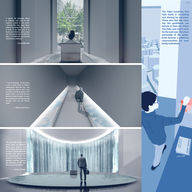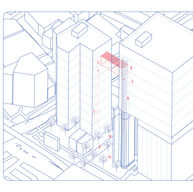从消除到升华:
東京孤獨树洞计划
Smell
Tokyo: the City of Loneliness
Loneliness is not Tokyo’s illness; it’s the status quo of the city. Given that loneliness is a comprehensive urban structural issue, the operative action should be in the scale of the whole city by applying a systematic approach -- a new layer of spiritual infrastructure in the city that serves to everyone.
Urban Tree Hole
People who feel lonely may not necessarily reach out to a friend for help. They might prefer a “tree hole”: a target that can be easily found around you, will not response or react to what you say, only provides a hollow space/enclosed shelter for anyone who want to spend a couple minutes with themselves.
We propose a plan of constructing Urban Tree Hole around Tokyo that provide small spaces in the city that those lonely individuals can enjoy being with themselves, with the space, and with loneliness.
Celebrate Loneliness with Tree, Sky, and Water
In our proposal there are three typologies of Urban Tree Hole being inserted into Shibuya, the downtown of Tokyo, by either reinvigorating redundant store on the street side, creating corridor between buildings, or excavating underground space.
In the space of Urban Tree Hole_01 visitor can enter a pop-up store where he can sit down and look at a street tree through the store window, and start a silent conversation with it. In Urban Tree Hole_02, visitor will walk through the corridor between two skyscrapers in which the city view is blocked, but the sky is reflected by tilted mirrors on both sides of the corridor. Urban Tree Hole_03 is an underground space beneath the Shibuya Crossing which collects “invisible” Tokyo water through run-off, and utilize the water to form a water feature for visitor to immerse.
城市中的孤独感,正是一个城市公共精神健康的问题。为具体讨论孤独在城市中的表现,我们的提案首先选取了研究城市——东京,一座快节奏,充满活力,但被一种群体性孤独感裹挟的世界级城市。结合在东京的生活体验和观察调研,我们发现东京城市的孤独感按不同年龄、身份等有不同的类型,在不同的场合里也有多样的表现。因此,我们提出一套情景为基的研究模型,用于展现各种典型的东京城市孤独。
高峰期地铁车厢里的上班族,漫画屋里独自阅读的年轻人,与公仔作伴进餐或坐在带隔板的单座拉面馆内的独食者,他们的孤独感该如何消除?又抑或,他们正在享受着孤独带来的另一份轻松感?若是如此,我们需要的不是消除孤独,而是为城市中的孤独者找到安身之处。
我们认为,对孤独的人而言,最困扰的并非孤独本身,而是社会看待孤独的方式,以及担心自己的孤独影响他人而给与他们的压力。
针对东京人“孤独”的精神健康问题,我们引入“树洞”的概念,一个容易找寻,不给他人形成困扰,不过分引起注意,提供包覆感缓解感的自我独处空间。为构建“东京树洞计划”,我们选取东京市中心的涉谷,并提出要以一套“精神基础设施”网络,为“孤独个体”提供治愈性的独处空间。我们在城市中或选取或植入小型空间,并依据不同的场地条件,创造不同类型的树洞。
三个设计手法迥异的树洞空间,我们在提出让孤独者独处的同时,也为他们准备了来自自然的陪伴者。无论是树、天还是水,我们希望在大城市中感受到强烈孤独的个体在与同样孤独的自然的相处中,得到一份慰藉和鼓舞。在空间设计策略思考之余,我们还在策略中提出配合“东京树洞计划”出版“树洞指南”手册,帮助孤独人群找寻散布于城市中的树洞空间。手册在人群中传递借阅,成为每一个孤独个体集体交流的工具。作为共享体验和记忆的树洞装置,以及作为共享媒介“树洞指南”手册,在构筑城市“精神基础设施”的同时,也为城市的公共生活中搭建起综合性的共享结构,实现对东京城市群体孤独感的缓解。









